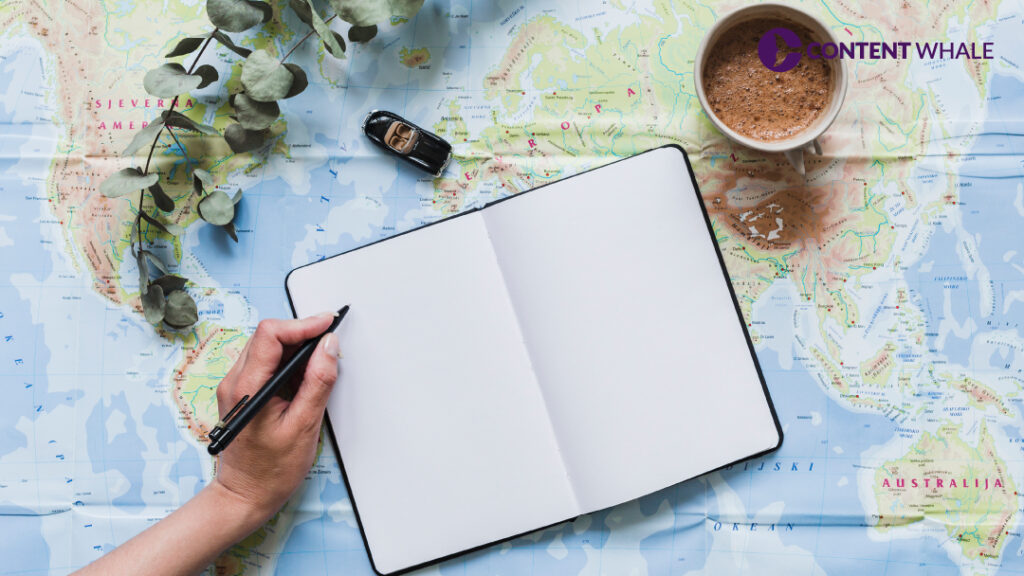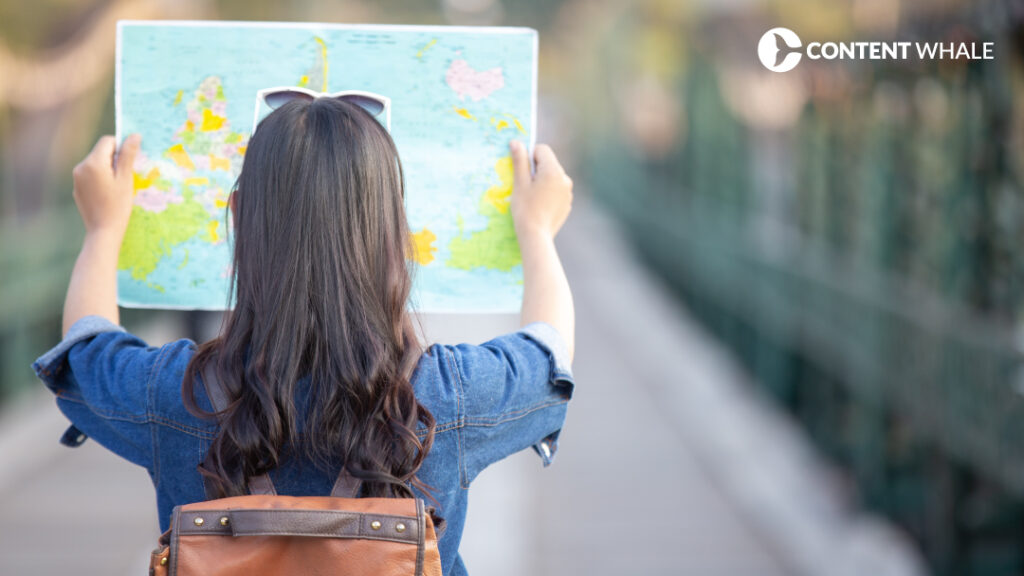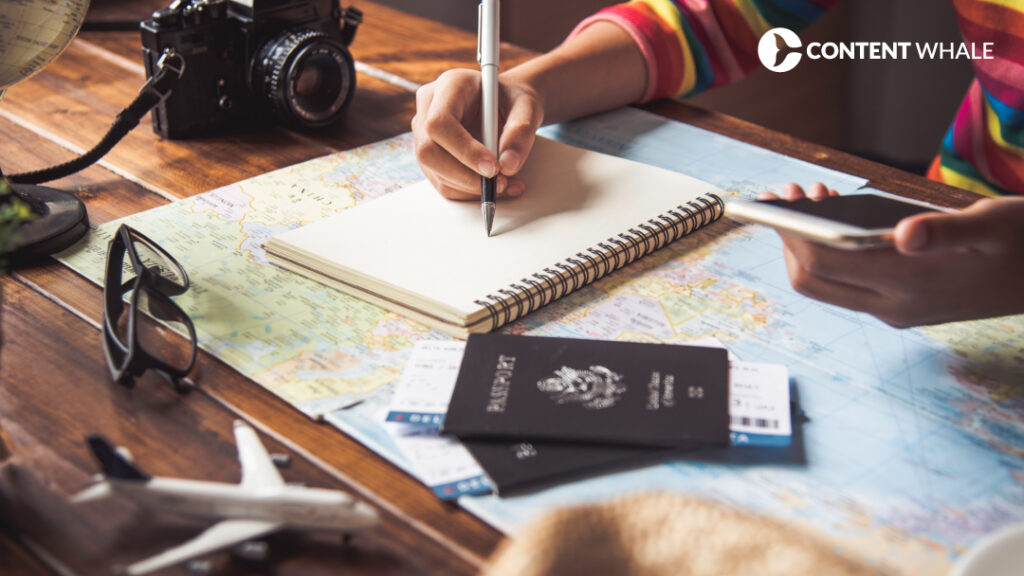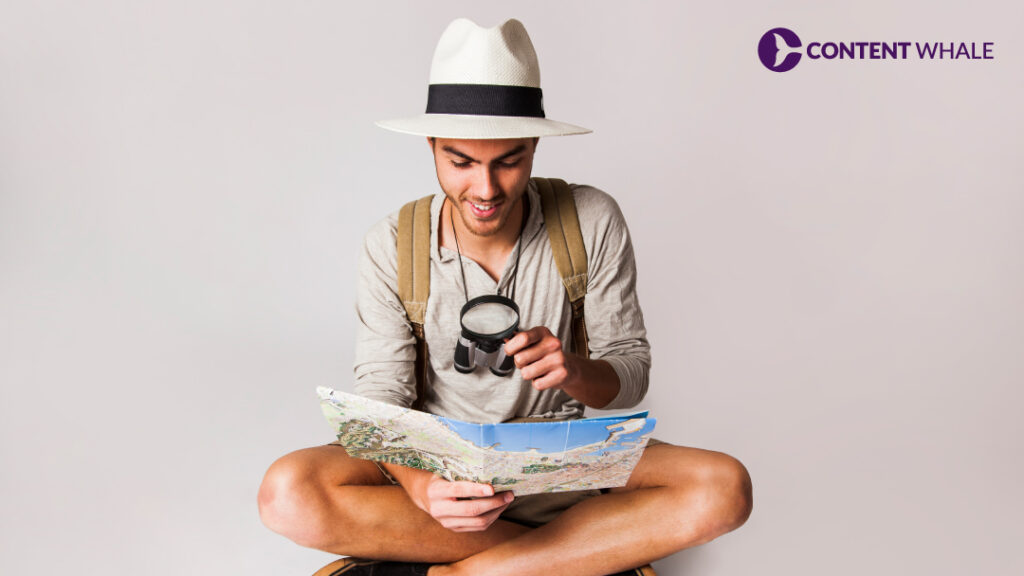You are standing at the edge of the Grand Canyon as the sun dips below the horizon, the sky painted in strokes of pink and orange. You’re overwhelmed by the sheer magnitude of nature’s beauty—a sight so stirring that you’re compelled to share it with the world.
This urge to document and express the essence of your travels is the heartbeat of a travelogue. Travelogues are more than just personal diaries or photo albums; they are a way to transport readers across the globe and into the heart of a traveler’s experience.
Travelogue writing combines the art of storytelling with the informative aspects of travel writing, allowing writers to explore the world and their experiences in it through a deeply personal lens.
From the lush, verdant jungles of the Amazon to the bustling, aromatic streets of Marrakech, travelogues capture the spirit of these locales, offering readers a taste of the world from the comfort of their own homes.
Hook Readers with a Captivating Travel Anecdote
Consider the moment when you first stepped onto the cobblestone streets of a centuries-old city, the air tinged with the scent of freshly baked bread and blooming flowers.
As you weave through the narrative of your travelogue, draw on these vivid sensory details to paint a picture so real that your readers can almost feel the sun on their faces and the cobblestones beneath their feet. This sensory immersion is the secret to crafting a captivating introduction that hooks your readers from the first paragraph.
Defining Travelogues and Their Historical Significance
A travelogue is essentially a bridge between an adventure journal and a cultural analysis, chronicling a journey while reflecting on the broader significance of the experience.
Historically, travelogues served as crucial tools for sharing knowledge about unexplored territories, cultures, and peoples, often influencing trade routes and exploration trends. They preserve the past and inform the future, making them invaluable both as historical documents and as sources of inspiration.
The Benefits of Writing Travelogues
Writing a travelogue is a deeply enriching practice that promotes personal growth by encouraging reflection on and articulated experiences. It allows you to share your journey with others, fostering a connection with readers who share your curiosity about the world.
Moreover, a well-crafted travelogue can inspire others to explore, step out of their comfort zones, and appreciate cultures and places unfamiliar to them.
Types of Travelogues
| Type | Description | Examples |
|---|---|---|
| Narrative | Focuses on the personal journey, rich in emotional depth and character development. | Exploring personal experiences in Morocco. |
| Historical | Delves into the history of the destinations, connecting past events with present experiences. | Linking historical sites with modern-day observations in Rome. |
| Food-Focused | Explores destinations through the lens of local cuisine, offering a taste of regional flavors and traditions. | Culinary adventures in Naples, Italy. |
| Photographic | Emphasizes visual storytelling, where photos convey the story as much as words. | Capturing vibrant markets in Istanbul through photography. |
Travelogues come in various forms, each offering a unique perspective on the world:
– Narrative Travelogues: These focus on the personal journey, rich in emotional depth and character development.
– Historical Travelogues: These delve into the history of the destinations, connecting past events with present experiences.
– Food-focused Travelogues: Explore destinations through the lens of local cuisine, offering a taste of regional flavors and culinary traditions.
– Photographic Travelogues: These emphasize visual storytelling, with photos conveying the story as much as words.
Guide Outline

This guide will cover several key aspects of travelogue writing:
- Finding Inspiration: How to choose captivating subjects and themes based on your travels.
- Crafting Your Narrative: Techniques for structuring your story and keeping readers engaged.
- Using Descriptive Language: Tips for using vivid language to bring your travels to life.
- Incorporating Practical Tips: How to blend useful travel tips with engaging storytelling for a well-rounded travelogue.
Your Inner Travel Writer: Inspiration and Planning
Embarking on the journey of writing a travelogue begins long before you pen the first word. It starts with a spark of inspiration and is followed by careful planning. Whether you’re reflecting on a recent adventure or preparing for a future escapade, the process of crafting a compelling travelogue is as thrilling as the journey itself.
Finding Your Muse in Travel
Inspiration is the cornerstone of all creative writing, and travelogues are no exception. Your muse can be anything from a breathtaking landscape to an intriguing local you meet along the way. To capture the essence of your travels, you need to be both present and reflective, observing not just the sights but the sensations, emotions, and stories behind them.
Experiencing Fully: Be truly present during your travels. Engage with locals, try new foods, participate in traditional activities, and soak up the atmosphere. Each of these experiences offers unique insights and anecdotes that can serve as the foundation for your travelogue.
Documenting Experiences: Carry a journal or a digital recorder to jot down impressions and details you might otherwise forget. Photos can also serve as powerful reminders of your experiences and can help jog your memory when you begin writing.
Planning Your Travelogue
Once you have gathered ample inspiration, the next step is to plan the structure and content of your travelogue. This involves deciding on the angle, the narrative style, and the key experiences you want to highlight.
Choosing a Theme: Depending on your journey and interests, you might focus your travelogue on a specific theme such as adventure, culture, cuisine, or history. For example, if culinary experiences deeply impacted you, a food-focused travelogue could be an exciting angle to explore, providing samples of a travelogue that would delight food enthusiasts.
Mapping Out the Structure: Plan how you will unfold your story. A chronological approach, where you narrate your experiences in the order they occurred, is straightforward and easy to follow. Alternatively, you might choose a thematic structure, grouping experiences based on different aspects of the culture or environment you explored.
Crafting a Compelling Introduction

| Element | Description | Tips |
|---|---|---|
| Hook | Start with a strong, evocative opening to draw readers in. | Use an intriguing question, a surprising fact, or a vivid description of a memorable moment. |
| Setting the Scene | Use rich, sensory details to immerse readers in the environment. | Describe sounds, sights, smells, and textures to create a vivid setting. |
| Developing a Narrative | Introduce the main themes and build a narrative arc with a clear beginning, middle, and end. | Start with a captivating moment, then unfold the travel experiences leading to personal or cultural insights. |
| Reflective Insights | Blend vivid descriptions with personal reflections to convey deeper meanings and personal growth. | Share how the experiences changed perceptions or contributed to personal development. |
The beginning of your travelogue should captivate your readers and draw them into your world. Start with a strong, evocative opening that sets the tone for the rest of your narrative.
Use a Captivating Hook: An intriguing question, a surprising fact, or a vivid description of a memorable moment can serve as great hooks. For example, describing the chaotic beauty of a bustling street market or the serene elation of reaching the top of a mountain can immediately engage your readers.
Integrating Descriptive and Reflective Writing
To truly resonate with your audience, your travelogue should blend vivid descriptions with personal reflections. This mix not only paints a picture of the destination but also conveys your personal journey and growth throughout your travels.
Descriptive Writing: Use sensory details to bring scenes to life. Describe what you saw, heard, smelled, touched, and tasted to help your readers experience the destination as vividly as you did.
Reflective Writing: Share how your experiences changed you or challenged your perceptions. Reflective writing can deepen the emotional impact of your travelogue, making it more than just an account of where you went and what you did—it becomes a journey of personal transformation.
Incorporating Practical Tips
While the primary focus of a travelogue is to share your personal experiences, including practical tips can add value for your readers, making it easier for them to imagine planning a similar trip. Tips on navigating local transportation, must-visit spots, or local customs can be both informative and engaging, enhancing the usefulness of your travelogue.
Finding Inspiration

The first step to writing a compelling travelogue is gathering inspiration. This can be achieved through various brainstorming techniques, such as creating mind maps that connect different aspects of your travels—from the sensory experiences to the emotions they evoked. Looking through travel photos can also reignite memories and highlight moments that might have slipped your mind.
Digging into your own travel experiences and zooming in on specific moments that left a mark on you can provide a rich foundation for your narrative. Perhaps it was a conversation with a local artisan or the serene quiet of a mountain trail at dawn—these experiences, when detailed, can captivate readers.
Many travelogue writers also draw inspiration from established figures in the genre. For example, reading Bill Bryson’s witty accounts in “Notes from a Small Island” or the poetic explorations of Pico Iyer in “The Art of Stillness” can ignite your creative spark. These authors show how personal perspectives can transform the depiction of a destination.
The power of unexpected encounters and cultural immersion cannot be overstated. These experiences often provide the most authentic and engaging content for a travelogue, offering readers insights into the locale and its people that go beyond typical tourist experiences.
Choosing a focus and understanding your target audience is crucial. Whether your travelogue caters to solo travelers, families on adventures, or history enthusiasts, the content should reflect the interests and needs of your readers. For instance, a travelogue focusing on solo travel might emphasize self-discovery and independence, while one on family travel could highlight activities suitable for all ages.
Deciding on the narrative structure is another significant step. You might opt for a chronological layout, which is straightforward and follows the natural progression of your journey. Alternatively, a thematic approach can focus on specific aspects of the culture, such as culinary experiences or local festivals, regardless of when they occurred during your travels.
Researching the destination’s history, culture, and geography enriches your narrative, providing readers with a deeper understanding of the location. This research can also uncover unique details that add a touch of local flavor—like mentioning a lesser-known local myth or a favorite street food dish.
Creating a rough outline is essential for organizing your thoughts and ensuring a coherent flow of your narrative. Identify key moments and potential anecdotes that you want to include. This outline will serve as your roadmap, guiding you as you weave your experiences into a narrative that captures the essence of your travels and resonates with your audience.
Mastering the Art of Storytelling

| Element | Techniques | Example |
|---|---|---|
| Setting the Scene | Use rich, sensory details to immerse readers in the environment. Describe environments vividly to set the emotional tone. | Describing the aromatic scents of street food and the vivid colors of a sunset in an urban setting. |
| Narrative Arc | Develop a beginning, middle, and end. Start with an intriguing hook, proceed with unfolding experiences, and end with reflective insights. | Beginning with a dramatic scene, continuing with challenges faced and interactions during travel, and concluding with lessons learned. |
| Character Development | Show personal growth and include other characters to enrich the story. Reflect on transformations and depict diverse perspectives. | Reflecting on overcoming fears and adapting to new cultures, including interactions with locals and fellow travelers. |
| Dialogue | Incorporate conversations to enhance authenticity and relate to personal growth or cultural insights. | Conversations with locals revealing insights into the local culture or personal anecdotes that show the traveler’s development. |
| Reflective Insights | Include reflections that connect experiences to broader themes like cultural understanding or personal identity. | Sharing how encounters with different cultures impacted personal worldview or future decisions. |
| Conclusion | End with a strong conclusion that wraps up the story and resonates emotionally with the reader. | Summarizing key insights, reflecting on the journey, and teasing potential future travels. |
Creating a travelogue that captivates and entertains requires more than just recounting the events of your journey; it demands the mastery of storytelling. This craft involves weaving your observations, experiences, and reflections into a narrative that not only informs but also engages and inspires your readers. Here’s how to elevate your travelogue from a simple trip report to a compelling story.
Setting the Scene
Every great story begins with a strong setting, and in travelogues, your destinations provide natural backdrops. To set the scene effectively, immerse your readers in the environment. Describe the bustling markets, serene landscapes, or the chaotic beauty of urban life with rich, sensory details. Consider the aromatic scents of street food, the cacophony of city sounds, or the vivid colors of a sunset. This not only paints a vivid picture but also sets the emotional tone of your narrative.
Developing a Narrative Arc
Like any good story, a travelogue benefits from a narrative arc that includes a beginning, middle, and end. This structure helps keep your readers engaged.
– Beginning: Introduce the key themes of your travelogue. Start with an intriguing hook—a compelling moment or a unique observation that sets the tone for the journey. This could be a dramatic scene or a reflective encounter that hints at the personal transformations to come.
– Middle: This is where the bulk of your travel experiences unfold. Present challenges you faced, interactions with locals, and personal revelations. Ensure that each segment contributes to the overall theme and adds depth to your narrative. Use anecdotes and personal stories to illustrate larger points about the culture and your experiences.
– End: Conclude your narrative on a reflective note. What did you learn from your travels? How have these experiences changed you? This section should resonate with your readers, leaving them with something to ponder or inspiring them to embark on their own adventures.
Character Development

In travelogues, you are a character in your own story, and how you develop over the course of your narrative can be deeply compelling. Reflect on your own transformations throughout the journey—how you overcame fears, adapted to new cultures, or discovered aspects of yourself. Additionally, bring to life the characters you meet along the way. From a wise local guide to a group of fellow travelers, these individuals can enrich your story, providing diverse perspectives and contributing to your journey’s educational and emotional layers.
Incorporating Dialogue
Dialogue can vivify your travelogue, turning it from a monologue into a lively narrative. Include conversations you had with locals or other travelers. These exchanges can reveal insights into the local culture or illustrate your personal growth. When used effectively, dialogue enhances the authenticity of your experiences and makes your story more relatable and engaging.
Reflective Insights
What sets travelogues apart from simple travel guides or blogs is the depth of personal insight. Throughout your narrative, incorporate reflections that connect your experiences to broader themes—be it cultural understanding, human connectivity, or personal identity. Share how these reflections impacted your view of the world or influenced your future decisions. This introspection not only deepens the narrative but also connects with readers on an intellectual and emotional level.
Visual and Sensory Language
Engage your readers’ senses by using descriptive, sensory language that brings your experiences to life. Instead of merely stating that you visited a historic site, describe the texture of the ancient stones, the sound of the crowd around you, or the intense heat of the afternoon sun. This type of writing helps readers visualize the scene and feel the emotions and sensations you experienced.
Ending with a Strong Conclusion
End your travelogue with a strong, impactful conclusion that wraps up your story beautifully and leaves your audience satisfied yet wanting more. Reflect on the journey, summarize key insights, and perhaps tease future adventures. This not only provides closure but also reinforces the emotional and thematic impacts of your narrative.
By mastering these elements of storytelling, your travelogue will transcend the ordinary, offering readers a window into not only your travels but also your heart and mind as a traveler. This connection is the ultimate achievement of any travel writer, turning simple journeys into unforgettable stories.
Finding Your Voice and Perspective
In travelogue writing, choosing the right voice and perspective is critical to connect authentically with your readers.
Deciding between a first-person or third-person narrative sets the tone for how personal or detached the story feels.
A first-person narrative brings readers into the heart of your personal experiences, imbued with your emotions and insights, making it ideal for sharing personal journeys and introspections.
In contrast, a third-person perspective offers a broader, more observational angle, useful for a more neutral or wide-reaching narrative.
Your writing style should be a reflection of your personality. If your interactions are often infused with humor, let your travelogue crackle with wit.
If you ponder deeply on experiences, your writing might be more reflective and insightful. Regardless of the style, maintaining honesty and authenticity is crucial. Authentic travel writing resonates with readers because it feels genuine and trustworthy, showcasing both the highs and the lows of travel, and providing a truthful representation of your experiences.
Building a Compelling Narrative

| Phase | Description | Strategies |
|---|---|---|
| Opening | Begin with a strong, engaging opening that captivates the audience. | Use a surprising detail or pose an intriguing question that invites readers into the adventure. |
| Narrative Development | Develop the narrative through a clear structure of beginning, middle, and end, enriched with conflicts and resolutions. | Set the scene, introduce main themes, detail conflicts or challenges faced, and describe moments of tension and their resolutions. |
| Personal Growth | Showcase personal growth and transformation throughout the narrative. | Reflect on changes in self-awareness, lessons learned, and shifts in perspectives due to the travel experiences. |
A strong opening is essential to captivate your audience from the outset. Begin with a surprising detail or pose an intriguing question that sets the stage for your adventure, enticing readers to dive deeper into your journey. For example, starting with a peculiar custom you encountered or a breathtaking view that left you speechless can effectively hook your audience.
To keep your readers engaged, your travelogue should have a clear narrative arc comprising a beginning, middle, and end. Start by setting the scene and introducing the main themes, then move into the body where the core of your experiences unfolds—include conflicts, moments of tension, and their resolutions to build a dynamic narrative.
Perhaps you faced a challenging hike or navigated a misunderstanding due to a language barrier; these experiences add depth to your story.
Throughout your narrative, showcase your personal growth and transformation. Reflect on how the trip changed you, what lessons you learned, and how your perspectives shifted. This not only enriches the narrative but also adds a layer of depth that can inspire and impact your readers, making your travelogue not just a recount of events but a journey of personal evolution.
Describing the Journey: The Power of Sensory Details
Effective travelogue writing transports readers to the destination through the power of descriptive language. By engaging all five senses—sight, sound, smell, taste, and touch—you allow your audience to experience the place vicariously. Each sensory detail you include builds a vivid, multi-dimensional picture of the landscapes, architecture, and local people.
Visual Details: Start with what you see, the most immediate form of sensory information. Describe the vibrant colors of a bustling market, the stark lines of modern architecture against an ancient landscape, or the expressive faces of local people. Use similes to compare and contrast what’s unfamiliar to your readers with what might be more recognizable, like comparing the red sand dunes to waves on a crimson sea.
Auditory Details: Next, incorporate what you hear. The rhythmic chants of street vendors, the cacophony of city traffic, or the serene silence of a mountain peak at dawn all add a layer of depth. Personification can bring sounds to life, such as “the old city walls whispered stories of ancient times.”
Olfactory and Gustatory Details: Smell and taste can be evocative senses that trigger deep memories. Describe the aromatic blend of spices wafting from a food stall or the salty breeze of a coastal town. Metaphors can effectively convey flavors and smells, likening them to familiar sensations to evoke a strong reaction from the reader.
Tactile Details: Lastly, consider what you touch or feel. The roughness of aged stone carvings, the comforting warmth of the sun as you walk through a deserted beach, or the brisk chill of mountain air can powerfully convey the atmosphere.
Including these evocative details captures the essence of the destination and makes your narrative immersive. Literary devices like similes, metaphors, and personification not only create vivid imagery but also enhance the emotional resonance of your descriptions, making the scenes and experiences stick with your readers long after they’ve finished reading.
Beyond the Narrative: Practical Tips for Enriching Your Travelogue

| Tip | Description | Example |
|---|---|---|
| Integrating Cultural Insights | Incorporate specific cultural insights to deepen the connection between the narrative and the reader. | Discussing the cultural significance of hanami in Kyoto, Japan, including a local’s perspective on the tradition. |
| Highlighting Local Experts | Add depth by referencing local guides or experts who provide unique insights into the location. | Mentioning how a local historian in Marrakech, Morocco, provided lesser-known facts about the city’s medina. |
| Showcasing Culinary Delights | Explore local cuisine to offer a gastronomic experience of the culture. | Describing how to make Neapolitan pizza with a renowned chef in Naples, Italy. |
| Using Dynamic Photography | Use visuals to enhance reader engagement and complement the narrative. | Featuring dynamic photographs of vibrant markets in Istanbul, Turkey. |
| Including Travel Tips | Provide practical travel tips to make the travelogue both engaging and useful. | Offering advice on the best times to visit, recommended gear, and health precautions for a trek through the Himalayas in Nepal. |
| Engaging with Technology | Discuss modern apps and resources that enhance travel experiences. | Mentioning WikiCamps Australia to find camping sites and amenities during an Australian Outback road trip. |
| Personal Anecdotes and Encounters | Weave in personal anecdotes involving specific people or events to enrich the narrative. | Describing a memorable encounter with a street artist in Paris, France, and its impact on the traveler’s perception of art. |
While the narrative spine of your travelogue carries the story, the flesh and bones are often built from practical insights and richer details that engage readers on another level. Here’s how to enhance your travel writing by incorporating specific tips and examples that bring authenticity and utility to your readers.
- Integrating Cultural Insights
To deepen the connection between your narrative and the reader, incorporate specific cultural insights that paint a more vivid picture of each destination. For example, when writing about Kyoto, Japan, don’t just mention the beauty of the cherry blossoms at Maruyama Park during hanami (flower viewing). Discuss the cultural significance of hanami, and maybe include a quote from a local explaining personal or historical perspectives. This not only provides color but also offers readers a glimpse into the Japanese way of life.
- Highlighting Local Experts
Referencing local guides or experts can add a layer of depth to your travelogue. While exploring the backstreets of Marrakech, Morocco, mention how a local historian like Fatima Zohra Rghioui helped uncover lesser-known facts about the city’s ancient medina. This approach not only enriches your narrative but also lends credibility to your descriptions.
- Showcasing Culinary Delights
Food is a universal connector and exploring local cuisine can significantly enrich your travelogue. While describing the culinary scene in Naples, Italy, you could talk about learning to make authentic Neapolitan pizza with a renowned chef like Enzo Coccia. Share the sensory details of the ingredients, the process, and even the taste of the pizza straight from the oven. Such specifics invite the reader to experience the culture gastronomically.
- Using Dynamic Photography
Visuals can dramatically enhance how your readers engage with your travelogue. If discussing the vibrant markets of Istanbul, Turkey, don’t just describe the riot of colors; show it through dynamic photographs. Collaborating with travel photographers who specialize in capturing the essence of a place, like Murad Osmann, famous for his “Follow Me To” series, can provide compelling visuals that complement your written words.
- Including Travel Tips
Readers often appreciate practical travel tips that make your narrative both engaging and useful. While recounting a trek through the Himalayas in Nepal, offer advice on the best times to visit, recommended gear lists, and potential health precautions, citing advice from seasoned trekkers like Tim Macartney-Snape. This type of information helps readers plan their own adventures and makes your travelogue a valuable resource.
- Engaging with Technology
Today, discussing mobile apps and resources can be incredibly helpful. For example, when detailing a road trip across the Australian Outback, mention apps like WikiCamps Australia, which helps locate camping sites and amenities. Suggesting technology that enhances travel experiences shows that your guide is modern and practical.
- Personal Anecdotes and Encounters
Finally, weaving in personal anecdotes involving specific people or events can greatly enrich your narrative. If you had a memorable encounter with a street artist in Paris, France, like the renowned portrait painter Olivier Binet, describe the scene, the conversation, and the portrait’s impact on your perception of art.
By including these specific names, places, and practical tips, your travelogue transcends mere storytelling. It becomes a treasure trove of insights and utilities, making it not only a source of inspiration but also a guide for others who might follow in your footsteps.
Enhancing Your Story with Multimedia
Today in the age of digital storytelling, integrating multimedia elements can significantly enrich your travelogue. High-quality photos and videos capture the essence of your destinations and bring your narratives to life.
When writing about the sun-drenched beaches of Bali, include vibrant photos of the sunset over the ocean, or embed a video clip showing the intricate dance of a traditional Balinese performance. Each visual should serve the story, providing a richer, more immersive experience.
Captions are important—they should add context, explain the significance of the image, or share interesting facts about the visual content.
For example, a photo of a bustling night market might include a caption about local dishes to try. These multimedia elements not only decorate your narrative but deepen the reader’s engagement, making your travelogue a multi-sensory journey.
Enhancing Readability: Formatting and Style
Focus on clarity and simplicity in your writing to ensure your travelogue is as accessible as it is engaging. Use concise language that conveys your experiences without overwhelming your readers.
Break up text with subheadings that guide readers through your narrative, and employ bullet points or numbered lists for easy-to-digest tips or highlights. Always proofread your work to maintain professionalism and credibility by avoiding grammatical mistakes and typos.
Adding Value for Travelers: Practical Information
Include essential logistical details to transform your travelogue from a simple recount of your journey into a valuable resource. Information on transportation options, like whether to take the tram or a taxi in Istanbul or recommendations for accommodations, such as eco-friendly hotels in Costa Rica, can be immensely helpful.
Share insights into local customs and etiquette, which are invaluable for travelers wanting to respect cultural norms. For instance, explaining the proper way to greet someone in Japan can enhance a visitor’s interaction with locals.
Highlight unique sights and experiences that stray from the beaten path, like a hidden gem café in Paris known only to locals or a rare hiking trail in New Zealand that offers breathtaking views.
Budget-friendly travel advice also adds tremendous value, offering suggestions for experiencing a destination without breaking the bank, such as free museum days or affordable street food options.
The Ultimate Guide: Sharing Your Travels and Inspiring the World

Travelogues play a pivotal role in fostering cultural understanding and connecting people from various backgrounds through shared experiences. They offer more than just travel tips; they provide insights into the cultural tapestry of destinations and encourage empathy and global awareness.
This guide has outlined key steps to create captivating travelogues—from finding your unique voice and crafting a compelling narrative to enhancing your story with multimedia and offering practical information. As you embark on your journey as a travel writer, remember to draw on personal experiences, vivid descriptions, and valuable insights to engage and inspire your readers.
We encourage you to document your adventures and share your stories. Whether through blogs, social media, or travel books, your travelogues can contribute to a greater understanding of the world. Connect with other travelers, exchange stories, and continue to explore the endless possibilities that travel writing offers. Let your journey inspire others to discover new places, cultures, and perspectives.
Bonus Section: Travelogue Examples for Inspiration

To inspire your own travelogue writing, let’s explore several exemplary works that embody various styles and focuses, each illustrating the principles discussed in this guide.
Historical Travelogue: “In Patagonia” by Bruce Chatwin
Chatwin’s travelogue brilliantly explores the rich historical tapestry of Patagonia. It blends fascinating accounts of past explorers with the stories of local inhabitants, showcasing a deep engagement with the region’s history and myths. This book exemplifies how effectively a travelogue can transport readers across time, providing a vivid sense of place through meticulous historical research and narrative flair.
Food-Focused Travelogue: “Eat, Pray, Love” by Elizabeth Gilbert
While not exclusively about food, the segments of Gilbert’s journey through Italy provide a succulent culinary exploration. Her descriptions of tasting Italian delicacies are both lush and evocative, offering readers a taste of local flavors while highlighting her personal emotional journey. Gilbert’s ability to intertwine food with self-exploration and renewal shows how culinary experiences can serve as a powerful narrative device in travel writing.
Humorous Travelogue: “Neither Here Nor There” by Bill Bryson
Bryson’s travelogue through Europe is a prime example of how humor can enhance travel writing. His witty observations and self-deprecating humor provide a light-hearted yet insightful look at the quirks and idiosyncrasies of various cultures. Bryson demonstrates how humor can not only entertain but also disarm and connect with the reader, making the travel experiences more relatable.
Solo Travelogue: “Wild” by Cheryl Strayed
Strayed’s account of her solo hike across the Pacific Crest Trail is a profound exploration of personal growth and self-discovery. Through vivid landscapes and brutal honesty about her physical and emotional challenges, “Wild” illustrates the transformative power of travel and solitude. This travelogue is a testament to the strength of the human spirit and the profound impact of venturing alone.
Now that you’ve seen how diverse and dynamic travelogues can be, it’s time to take your inspiration and turn it into action.
Start planning your next adventure, whether it’s a journey to a far-off land or a deeper exploration of local culture.
As you travel, remember the elements that make a great travelogue: vivid descriptions, personal reflection, and a narrative that draws the reader into your experience.
Grab your notebook or camera, and set out to create a travelogue that not only captures the essence of your journey but also shares your unique perspective with the world. Write, share, inspire—your next great adventure awaits!

What are the essential qualities of a good travelogue?
A good travelogue captivates with an engaging narrative, offers vivid descriptions that transport readers, and provides practical information that enhances the travel experience.
How do I choose a topic for my travelogue?
Begin with brainstorming techniques like mind mapping or reflecting on memorable aspects of your travel. Focus on areas where you have a personal connection or unique insights that can captivate your audience.
What are some common mistakes to avoid while writing a travelogue?
Avoid clichés and overly generic descriptions that don’t add value. Ensure your travelogue has a clear focus and purpose, keeping it engaging and informative without drifting into irrelevance.
How can I incorporate humor and personal anecdotes into my travelogue?
Use self-deprecating humor and share relatable experiences that resonate with your readers. This approach can make your narrative more engaging and personable.
Where can I find inspiration from other travel writers?
Look for inspiration in travel blogs like Nomadic Matt, books by authors like Paul Theroux, and online resources such as the travel section of The New York Times.
How can I promote my travelogue once it’s written?
Share your work on social media platforms, participate in travel forums, and engage with online travel communities. These channels offer great opportunities to reach a wider audience and connect with like-minded individuals.





